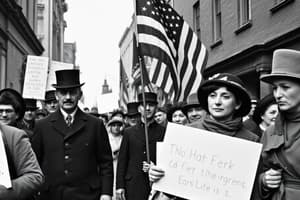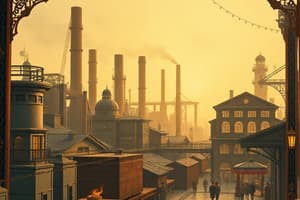Podcast
Questions and Answers
Which technological invention is associated with Thomas Edison?
Which technological invention is associated with Thomas Edison?
- Record player (correct)
- Airplanes
- Telephone
- Assembly line
What economic phenomenon is characterized by a boom-or-bust cycle?
What economic phenomenon is characterized by a boom-or-bust cycle?
- Immigrant influx
- Panic of 1873 (correct)
- Horizontal integration
- Technological stagnation
What was the primary business strategy employed by Standard Oil under John Rockefeller?
What was the primary business strategy employed by Standard Oil under John Rockefeller?
- Price gouging
- Diversification
- Vertical integration
- Horizontal integration (correct)
Which factor contributed to the interconnectedness of the global economy during the Gilded Age?
Which factor contributed to the interconnectedness of the global economy during the Gilded Age?
Who is recognized for developing the first successful airplane?
Who is recognized for developing the first successful airplane?
What does the term 'Gilded Age' refer to?
What does the term 'Gilded Age' refer to?
Which corporation was founded by John D. Rockefeller?
Which corporation was founded by John D. Rockefeller?
What major factor did Jay Cooke's bankruptcy during the Panic of 1873 highlight?
What major factor did Jay Cooke's bankruptcy during the Panic of 1873 highlight?
What business strategy did Carnegie Steel exemplify?
What business strategy did Carnegie Steel exemplify?
Which of the following industries did not experience vertical integration by a major corporate owner?
Which of the following industries did not experience vertical integration by a major corporate owner?
What was the role of J.P. Morgan during the Panic of 1893?
What was the role of J.P. Morgan during the Panic of 1893?
What major legislation did Grover Cleveland sign into law in 1890?
What major legislation did Grover Cleveland sign into law in 1890?
Which president is known for being elected to two non-consecutive terms?
Which president is known for being elected to two non-consecutive terms?
What factor led to a significant number of immigrants arriving in the U.S. during the Industrial Revolution?
What factor led to a significant number of immigrants arriving in the U.S. during the Industrial Revolution?
Which immigrant group was specifically barred from entering the United States by the Chinese Exclusion Act of 1882?
Which immigrant group was specifically barred from entering the United States by the Chinese Exclusion Act of 1882?
What significant change did the Industrial Revolution bring to American society?
What significant change did the Industrial Revolution bring to American society?
What was one consequence of the Rope Crash during the Panic of 1893?
What was one consequence of the Rope Crash during the Panic of 1893?
During which presidential administration did the Republican Party face a split into Stalwarts and Progressives?
During which presidential administration did the Republican Party face a split into Stalwarts and Progressives?
What was a common experience for immigrants arriving at Ellis Island?
What was a common experience for immigrants arriving at Ellis Island?
What contributed to the rise of anti-Semitism during the Gilded Age?
What contributed to the rise of anti-Semitism during the Gilded Age?
What was one major effect of the Industrial Revolution on urban areas?
What was one major effect of the Industrial Revolution on urban areas?
Which of the following accurately describes the term 'Applicable Economic Beliefs' as introduced during international business expansion?
Which of the following accurately describes the term 'Applicable Economic Beliefs' as introduced during international business expansion?
Flashcards
Gilded Age (1870s-1900s)
Gilded Age (1870s-1900s)
A period in late 19th century America marked by rapid industrial growth, vast wealth inequality, and a superficial obsession with wealth.
Standard Oil
Standard Oil
A large oil company founded by John D. Rockefeller, known for its aggressive business practices and near-monopoly in the oil refining industry.
Horizontal Integration
Horizontal Integration
A strategy where a company takes control of similar businesses in the same industry.
Panic of 1873
Panic of 1873
Signup and view all the flashcards
Jay Cooke's Bankruptcy
Jay Cooke's Bankruptcy
Signup and view all the flashcards
Record player
Record player
Signup and view all the flashcards
Assembly lin
Assembly lin
Signup and view all the flashcards
Telephone
Telephone
Signup and view all the flashcards
Vertical Integration
Vertical Integration
Signup and view all the flashcards
Carnegie Steel
Carnegie Steel
Signup and view all the flashcards
J.P. Morgan
J.P. Morgan
Signup and view all the flashcards
The Rope Crash
The Rope Crash
Signup and view all the flashcards
U.S. Steel Corporation
U.S. Steel Corporation
Signup and view all the flashcards
Gilded Age
Gilded Age
Signup and view all the flashcards
Middle Class Expansion
Middle Class Expansion
Signup and view all the flashcards
Department Stores
Department Stores
Signup and view all the flashcards
Clean Cities
Clean Cities
Signup and view all the flashcards
Commuters and Suburbs
Commuters and Suburbs
Signup and view all the flashcards
Civil Service Reform
Civil Service Reform
Signup and view all the flashcards
Sherman Antitrust Act
Sherman Antitrust Act
Signup and view all the flashcards
Era of Forgotten Presidents
Era of Forgotten Presidents
Signup and view all the flashcards
Global Economic Influence
Global Economic Influence
Signup and view all the flashcards
Study Notes
Immigration Patterns (1820-1920)
- Immigration sources shifted over time from 1820 to 1920.
- 1820-1840: 43% from the UK, 27% from Germany, 18% from Ireland, 1% from other countries, and 11% from unspecified sources.
- 1840-1860: 40% from the UK, 27% from Germany, 16% from Ireland, 12% from other areas, and 5%, unspecified origin.
- 1860-1900: 28% from Germany, 18% from other European countries, 10% from Ireland, 6% from Russia, and 11% from unspecified regions. 4% from Asia and 8% from other unspecified regions.
Gilded Age Technology
- Late 1800s inventions dramatically changed American life.
- Key inventions: telephone, light bulb, record player, automobiles, assembly line, airplanes.
- General Electric, founded by Edison, became a major corporation.
- Edison's light bulb, the Wright Brothers' first flight, Alexander Graham Bell's telephone, and an early record player are milestones of the era.
Corporations and Monopolies
-
Large corporations were necessary to manage new technologies.
-
The "Gilded Age" describes late 1800s America, showcasing shallow wealth worship.
-
The economy experienced boom-and-bust cycles (i.e., the Panic of 1873).
-
Jay Cooke's bankruptcy highlighted global economic interconnectedness (e.g., wheat prices collapsing due to European competition.)
-
John D. Rockefeller's Standard Oil exemplified a powerful, money-driven corporation using aggressive tactics in the industrial revolution.
-
Standard Oil used horizontal integration (buying competitors) to control most oil refineries.
-
Andrew Carnegie controlled the steel industry through similar tactics but used vertical integration (controlling every stage of production).
-
J.P. Morgan, a banker, amassed wealth through company boards and mergers. Notably, he saved the USA from the Panic of 1893.
-
U.S. Steel, formed by Morgan, was the first billion-dollar company.
Rockefeller's Philosophy (on Business)
- "The growth of a large business is merely a survival of the fittest. This is not an evil tendency in business. It is merely the working out of a law of nature and a law of God."
Carnegie's Philosophy (on Wealth)
- "Not evil, but good, has come to the race from the accumulation of wealth by those who have the ability and energy that produces it."
- "The law of competition is best for the trade, because it insures the survival of the fittest in every department."
Middle Class Life
- The Industrial Revolution created a substantial American middle class, mostly urban/suburban.
- This class significantly changed societal expectations and actions (buying more and more products, etc.).
- Cities invested heavily in infrastructure, such as clean water and commuter rail systems.
- Technological advancements like electric lighting, elevators, and trolleys improved urban life.
- William Graham Sumner, a Yale sociologist, noted that the industrial revolution deeply affected everyone in America.
Gilded Age Politics
-
Republicans held political power with a prosperous economy, and Americans generally voted Republican.
-
James Garfield (Republican) promoted civil service reform but was assassinated.
-
Chester A. Arthur, who succeeded Garfield, led the reform effort.
-
The Republican Party divided into Stalwarts (focused on the South) and Progressives (on economic growth).
-
Grover Cleveland (Democrat) opposed Republican international expansion but supported economic growth.
-
In 1888, Cleveland lost his reelection bid to Benjamin Harrison (R), and Harrison signed the Sherman Antitrust Act into law to prohibit anti-competitive business activities.
-
Cleveland won a rematch in 1892 but his second presidency was affected by the Panic of 1893.
-
The period between Hayes' presidency (1877) and Cleveland's (1897) is known as the Era of Forgotten Presidents.
International Expansion
- American businesses and economic views spread internationally.
- Many countries adopted American business practices.
- The USA had substantial economic interests in Cuba and Mexico, and traded with Korea, Africa, and other regions.
Immigration during the Industrial Revolution
-
Millions of Europeans and Asians migrated to the US seeking economic opportunities.
-
Groups included Irish, Russian Jews, Italians, Poles, Japanese, French Canadians, and Mexicans.
-
The Chinese Exclusion Act of 1882 restricted Chinese immigration.
-
Immigrants faced harsh conditions at Ellis Island (Europeans) and Angel Island (Asians).
-
Immigrants often maintained their cultures but assimilation typically took 1-2 generations.
-
The Catholic Church welcomed many migrants, and communities formed neighborhoods in major cities.
-
Jews generally had more financial success.
-
Antisemitism was common. Immigrants persisted in the face of distrust from native-born Americans.
Studying That Suits You
Use AI to generate personalized quizzes and flashcards to suit your learning preferences.




